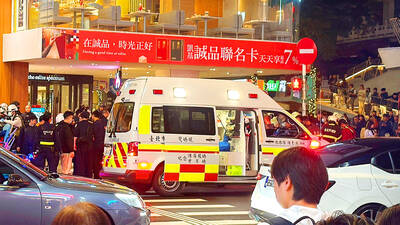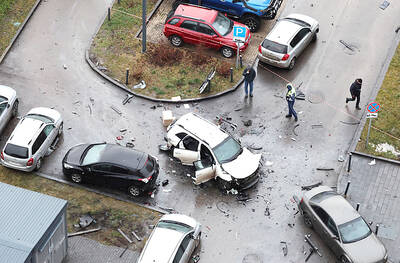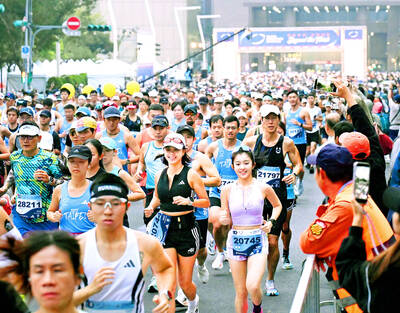A new “carrier killer” missile that has become a symbol of China’s rising military might will not force the US Navy to change the way it operates in the Pacific, a senior Navy commander said.
Defense analysts say the Dong Feng 21D missile could upend the balance of power in Asia, where US aircraft carrier battle groups have ruled the waves since the end of World War II.
However, Vice Admiral Scott van Buskirk, commander of the US 7th Fleet, said that the Navy does not see the much-feared weapon as creating any insurmountable vulnerability for the US carriers — the Navy’s crown jewels.
“It’s not the Achilles heel of our aircraft carriers or our Navy — it is one weapons system, one technology that is out there,” Van Buskirk said in an interview this week on the bridge of the USS George Washington, the only carrier that is home-based in the western Pacific.
The DF-21D is unique in that it is believed capable of hitting a powerfully defended moving target — like the USS George Washington — with pinpoint precision. That objective is so complex that the Soviets gave up on a similar project.
The missile would penetrate defenses because its speed from launch would not allow enough time for carriers or other large ships to complete countermeasures.
That could seriously weaken Washington’s ability to intervene in any potential conflict over Taiwan or North Korea, as well as deny US ships safe access to international waters near China’s long coastline.
Van Buskirk, whose fleet is responsible for most of the Pacific and Indian oceans, with 60-70 ships and 40,000 sailors and Marines under its command, said the capabilities of the Chinese missile are as yet unproven. However, he acknowledged it does raise special concerns.
“Any new capability is something that we try to monitor,” he said.
“If there wasn’t this to point to as a game changer, there would be something else,” he said. “That term has been bandied about for many things. I think it really depends on how you define the game, whether it really changes it or not. It’s a very specific scenario for a very specific capability — some things can be very impactful.”
The development of the missile comes as China is increasingly venturing further out to sea and is becoming more assertive around its coastline and in disputes over territory.
Late last year, China and Japan were locked in a heated diplomatic row over several islands both claim in the East China Sea, an area regularly patrolled by US Navy vessels. A flotilla of 10 Chinese warships, including advanced submarines and destroyers, passed through the Miyako Strait last April in the biggest transit of its kind to date.
Experts saw it as an attempt by China to test Japan and the US and demonstrate its open water capabilities.
Van Buskirk said the US Navy has no intention of altering its mission because of the new threat and will continue to operate in the seas around Japan, South Korea, the Philippines and anywhere else it deems necessary.
“We won’t change these operations because of this specific technology that might be out there, but we will carefully monitor and adapt to it,” he said.
The faster-than-expected development of the missile has set off alarm bells in Washington.
In December, Admiral Robert Willard, the head of the US Pacific Command, told Japan’s Asahi Shimbun he believed the missile program had achieved “initial operational capability,” meaning a workable design had been settled on and was being further developed.
At its most capable, the DF-21D could be launched from land with enough accuracy to penetrate the defenses of even the most advanced moving aircraft carrier at a distance of more than 1,500km.
To allay regional security fears, van Buskirk said, China needs to be more forthcoming about its intentions.

TRAGEDY STRIKES TAIPEI: The suspect died after falling off a building after he threw smoke grenades into Taipei Main Station and went on a killing spree in Zhongshan A 27-year-old suspect allegedly threw smoke grenades in Taipei Main Station and then proceeded to Zhongshan MRT Station in a random killing spree that resulted in the death of the suspect and two other civilians, and seven injured, including one in critical condition, as of press time last night. The suspect, identified as a man surnamed Chang Wen (張文), allegedly began the attack at Taipei Main Station, the Taipei Fire Department said, adding that it received a report at 5:24pm that smoke grenades had been thrown in the station. One man in his 50s was rushed to hospital after a cardiac arrest

A car bomb killed a senior Russian general in southern Moscow yesterday morning, the latest high-profile army figure to be blown up in a blast that came just hours after Russian and Ukrainian delegates held separate talks in Miami on a plan to end the war. Kyiv has not commented on the incident, but Russian investigators said they were probing whether the blast was “linked” to “Ukrainian special forces.” The attack was similar to other assassinations of generals and pro-war figures that have either been claimed, or are widely believed to have been orchestrated, by Ukraine. Russian Lieutenant General Fanil Sarvarov, 56, head

SAFETY FIRST: Double the number of police were deployed at the Taipei Marathon, while other cities released plans to bolster public event safety Authorities across Taiwan have stepped up security measures ahead of Christmas and New Year events, following a knife and smoke bomb attack in Taipei on Friday that left four people dead and 11 injured. In a bid to prevent potential copycat incidents, police deployments have been expanded for large gatherings, transport hubs, and other crowded public spaces, according to official statements from police and city authorities. Taipei Mayor Chiang Wan-an (蔣萬安) said the city has “comprehensively raised security readiness” in crowded areas, increased police deployments with armed officers, and intensified patrols during weekends and nighttime hours. For large-scale events, security checkpoints and explosives

PUBLIC SAFETY: The premier said that security would be tightened in transport hubs, while President Lai commended the public for their bravery The government is to deploy more police, including rapid response units, in crowded public areas to ensure a swift response to any threats, President William Lai (賴清德) said yesterday after a knife attack killed three people and injured 11 in Taipei the previous day. Lai made the remarks following a briefing by the National Police Agency on the progress of the investigation, saying that the attack underscored the importance of cooperation in public security between the central and local governments. The attack unfolded in the early evening on Friday around Taipei Main Station’s M7 exit and later near the Taipei MRT’s Zhongshan